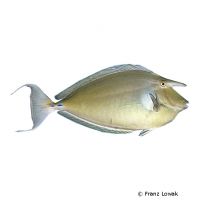Spotted Unicornfish (Naso brevirostris)
| Spotted Unicornfish Naso brevirostris | |
|---|---|
| Name | Spotted Unicornfish |
| Name Lat. | Naso brevirostris |
| Family | Surgeonfishes |
| Family lat. | Acanthuridae |
| Order | Surgeonfishes |
| Order lat. | Acanthuriformes |
| Origin | Indo-Pacific |
| Habitat | Lagoons, seaward reefs |
| Diet | Omnivore |
| pH | 8.1-8.4 |
| Hardness | 8-10 °KH |
| Behavior | Semi-aggressive |
| Keeping | Pair, group |
| Reef Compatible | Yes |
| Care Level | Difficult |
| Life Span | 5-10 years |
| Protection | No |
| Metric Units | |
| Size | 60 cm |
| Temperature | 24-28 °C |
| Salinity | 33-36 ‰ |
| Aquarium | ~ 3.000 l |
| US Units | |
| Size | 24" |
| Temperature | 75-82 °F |
| Salinity | 1.020-1.025 sg |
| Aquarium | ~ 800 gal |
Distribution and habitat
The range of Naso brevirostris is the Red Sea and the Indian and Central Pacific Oceans, from the coast of East Africa to southern Japan and Hawaii, where they live mostly in lagoons and on steeply sloping outer reefs to depths of 50 meters.
Maintenance
They require a well-structured aquarium with a lot of swimming space and a reef structure (hiding, resting and retreat possibilities) with living stones that act like a biological filter as well as fine-grained sand surfaces. Only lime-rich, heavy metal-free substrates may be used as substrate
Filters, skimmers and heaters are necessary to ensure water quality, as well as pumps to simulate tides, swells and bottom currents. Lighting must match the species-appropriate day-night rhythm of the animals
| Salinity: 33-36 ‰ | pH value: 8.1-8.4 |
| Carbonate hardness: 8-10 °KH | Nitrate content: 2-8 mg/l |
| phosphate content: 0.01-0.1 mg/l | nitrite content: 0.0-0.05 mg/l |
For salinity, an average value should be aimed for, which may only vary slightly by +/- 0.5 ‰. Ammonia and ammonium must not be measurable. Special attention must be paid to constantly good water quality.
Diet
The young fish require mainly plant food. After the horn has formed, they eat more plankton. The feed change usually succeeds without problems. The food supply should consist of a commercially available, vitamin-enriched frozen special food mix for plankton eaters or a combination of live and frozen food, such as mysis, plankton, artemia and krill with small-cut shrimp and mussel meat. In addition, they need plenty of commercially available algae and kelp (e.g. nori, caulerpa, kelp) supplemented with high-quality flake or granulated food for herbivores. The plant food strengthens their immune system and reduces aggression. Fine coral sand serves as a digestive aid for them
It is recommended to feed small portions several times a day (3-5 times). Regular and varied feeding promotes health and increases resistance.
Behaviour and compatibility
Since these lively and swimming fish usually live in loose groups or shoals, it is recommended to always keep several animals at the same time. To avoid ranking fights, one group should be added to the aquarium at a time. They are often aggressive against other surgeonfish, towards all other fish they behave peacefully.
Sex dimorphism
No external distinguishing characteristics are known. Juveniles lack the horn, which develops only from a body length of about 15 cm in both sexes.
Reproduction and breeding
There are no known reports of successful breeding in the aquarium.
Important
They require a lot of swimming space, so a center reef setup in the aquarium that these permanent swimmers can circle is recommended
They have spines (scalps) on both sides of the caudal peduncle, which can easily get caught in the net when caught and cause painful stinging injuries when touched.
As coral reef dwellers, they should not be maintained in a fish-only aquarium.
If different species are kept together, care should be taken to ensure that the fish are compatible in terms of water quality and temperature requirements and social behavior, and that the setup meets the needs of all species kept together. New fish to be introduced must be acclimated slowly to the water in the aquarium.
Further literature can be found in your pet store.
References
Text: Werner Winter; Image: Franz Lowak
Source: KUITER, DEBELIUS (2007): Atlas der Meeresfische: Die Fische an den Küsten der Weltmeere, Kosmos Verlag; BAENSCH & DEBELIUS (2006): Meerwasser Atlas Bd. 1, Mergus Verlag; ENGELMANN (2005): Zootierhaltung - Tiere in menschlicher Obhut: Fische, Verlag Harri Deutsch
- Gemäß § 21 Abs. 5 Tierschutzgesetz idgF
